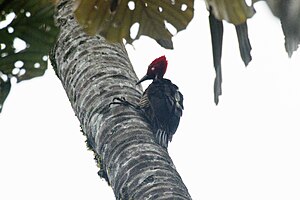Guayaquil woodpecker
| Guayaquil woodpecker | ||||||||||
|---|---|---|---|---|---|---|---|---|---|---|

Guayaquil woodpecker ( Campephilus gayaquilensis ) |
||||||||||
| Systematics | ||||||||||
|
||||||||||
| Scientific name | ||||||||||
| Campephilus gayaquilensis | ||||||||||
| ( Lesson , 1845) |
The Guayaquil woodpecker ( Campephilus gayaquilensis ) is a woodpecker found in southern Colombia , Ecuador, and northern Peru . Its natural habitat are subtropical and tropical forests. The habitat of the Guayaquil woodpecker is threatened by deforestation for agriculture and livestock. The remaining forest areas are small and fragmented so that viable populations can hardly exist and it seems inevitable that they will die out. The IUCN classifies the species as potentially endangered (NT, Near Threatened).
features
The Guayaquil woodpecker is a large woodpecker with red head plumage and red feather hood , which reaches a body length of 32 to 34 cm and a weight of 230 to 253 g.
The chin and throat are black with a few red spots. A wide white band runs over the black neck to the shoulder feathers and forms a V-shaped pattern on the back. In the female the stripe continues up to the beak, in the male the head is predominantly red, only below the ear covers there is a white spot. The coat (area between the neck and shoulder feathers) and tail are black, rump and upper tail-coverts are banded black and white or yellow-brown. The wings are brown, the wings brownish with a small ocher-yellow or yellow-brown spot on the inner vane . The lower wings are whitish. The plumage is banded black and yellow-brown from the chest to the rump.
The iris is yellow, the beak ivory or gray and the legs greyish.
distribution
The range of the Guayaquil woodpeckers is limited to the western slopes of the Andes and the adjacent lowlands from southwest Colombia ( Departamento del Cauca ) through western Ecuador to northwest Peru (to the south of Cajamarca ).
Habitat and way of life
The Guayaquil woodpecker is a resident bird and inhabits dry deciduous and wet forests as well as high secondary forests and mangroves from sea level up to heights of 800 m, occasionally in the south up to 1800 m. Details about its diet are not documented, it may be similar to that of the black-throated woodpecker ( Campephilus melanoleucos ). The breeding season lasts at least from October to May in West Ecuador. The nest is built in July, and pairs with young animals have been observed in October. Further details are not known.
Taxonomy and subspecies
René Primevère Lesson originally described it under the name Picus gayaquilensis . No subspecies of the Guayaquil woodpecker are described, it is therefore considered to be monotypical .
Individual evidence
- ↑ a b c Campephilus gayaquilensis in the IUCN Red List of Threatened Species 2017-2. Posted by: BirdLife International, 2016. Retrieved September 26, 2017.
- ↑ a b c H. Winkler, DA Christie (2017): Guayaquil Woodpecker (Campephilus gayaquilensis). In: del Hoyo, J., Elliott, A., Sargatal, J., Christie, DA & de Juana, E. (eds.). Handbook of the Birds of the World Alive. Lynx Edicions, Barcelona. ( Online )
- ^ A b Gerard Gorman: Woodpeckers of the World: The Complete Guide. Christopher Helm / Bloomsbury, 2014, ISBN 978-1408147153 , p. 413.
- ^ René Primevère Lesson: Description de trois espèces nouvelles de Pics . In: L'Echo du Monde Savant (= 2 ). tape 12 , no. 52 , 1845, pp. 755-758 ( biodiversitylibrary.org ).
- ^ IOC World Bird List Woodpeckers
